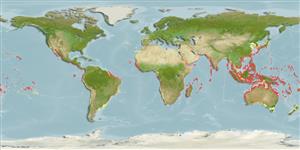Common names from other countries
Environment: milieu / climate zone / depth range / distribution range
Sinh thái học
; Mức độ sâu 1 - 31 m (Ref. 102164). Tropical
Indo-Pacific and Atlantic Ocean.
Length at first maturity / Bộ gần gũi / Khối lượng (Trọng lượng) / Age
Maturity: Lm ? range ? - ? cm
Thalli prostrate, greenish to purple, forming thick clumps of intricating branches on rocky substrate. Branches terete to slightly compressed, 1.5 to 3 mm broad. Branching irregularly alternate to opposite, forming wide angles and rounded axils. Branches divided into short stubby spines at the terminal portion; the short ultimate branchlets are characteristically stout, stubby, and spinose. Thalli up to 8 cm in height (Ref. 80758).
Source of protein and carrageenan; used for human consumption, as animal feed, medicine (antitumor) and as fertilizer; used as coconut manure in Brazil and West Indies (Ref. 80758); of low commercial interest internationally as carrageenan source (Ref. 82223). Hypnea plants have compounds with medical and pharmaceutical uses such as muscle relaxants and blood agglutinins (reviewed in Schenkman, 1989) (Ref. 82232). Inhabits well in rocky habitats exposed to moderate wave action, usually lodged between coral rocks in subtidal areas (Ref. 80758); found in the high subtidal or lower intertidal zones of relatively sheltered rockflats or mudflats and sandbanks, restricted to areas where persistent low water salinity was likely to be rare (Ref. 82232). Thomas Subbaramaiah (1994) reported that growth of H. pannosa in Mandapam, India was best at lower temperatures and higher salinities (Ref. 82232). In Corpus Cristi, Suva Harbour, Fiji, H. pannosa were found but not very abundant; in Nasese/Nasova (near Ratu Sukuna Road junction), Suva Harbour, Fiji, plants of H. pannosa were abundant, but fairly small. Hypnea was very stunted, being usually >50 mm in length and often covered with filamentous epiphytes. In Draunibota Island, Suva Harbour, Fiji, isolated small H. pannosa plants were found entangled with turtlegrasses, but were not abundant. The sandee lee side of Tokatoka ni Kubu Reef has scattered plants of G.maramae and H. pannosa. In Laucala Island, Suva Harbour, Fiji, attached to or entangled with the turtlegrasses were small (>100 mm) seaweed plants identified as Gracilaria maramae and Hypnea pannosa (Ref. 82232).
Guiry, M.D. and G.M. Guiry. 2009. (Ref. 80701)
IUCN Red List Status (Ref. 130435)
CITES status (Ref. 108899)
Not Evaluated
Not Evaluated
Threat to humans
Human uses
Các nghề cá: Tính thương mại
| FishSource |
Các công cụ
Thêm thông tin
Age/SizeSự sinh trưởngLength-weightLength-lengthHình thái họcẤu trùngSự phong phú
Các nguồn internet
Estimates based on models
Preferred temperature
(Ref.
115969): 22.7 - 29.2, mean 28.1 (based on 4511 cells).
